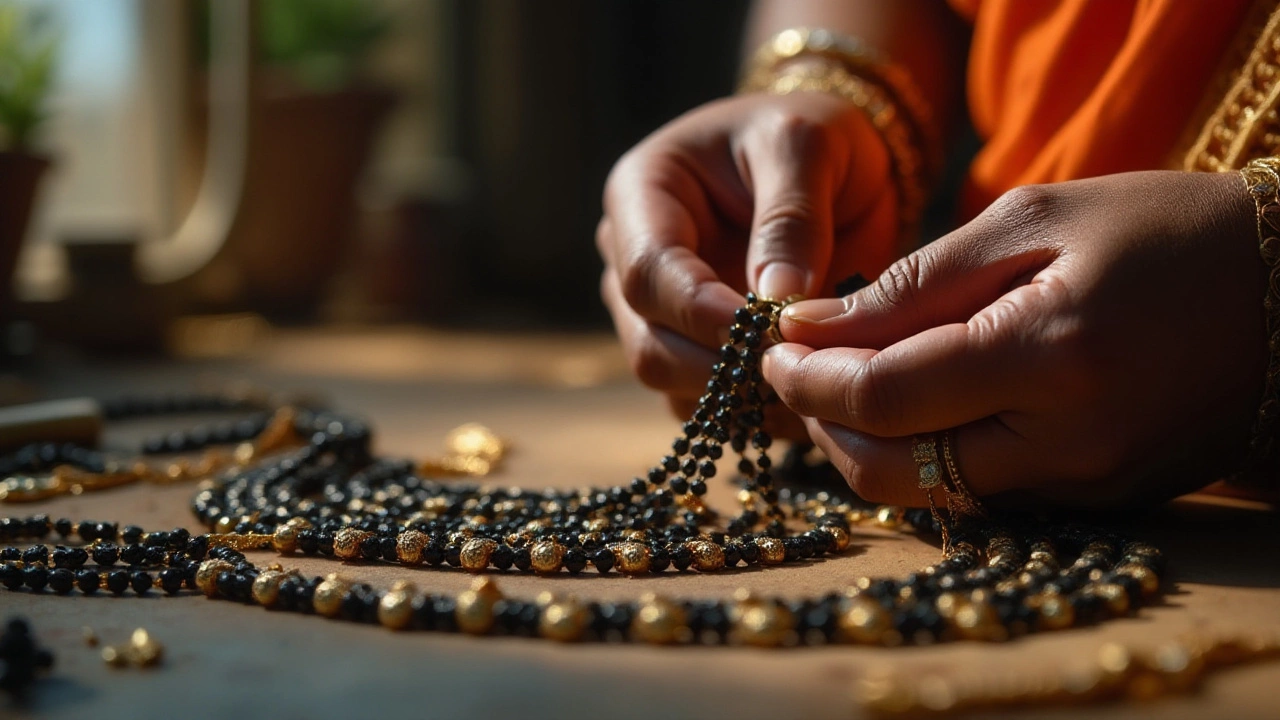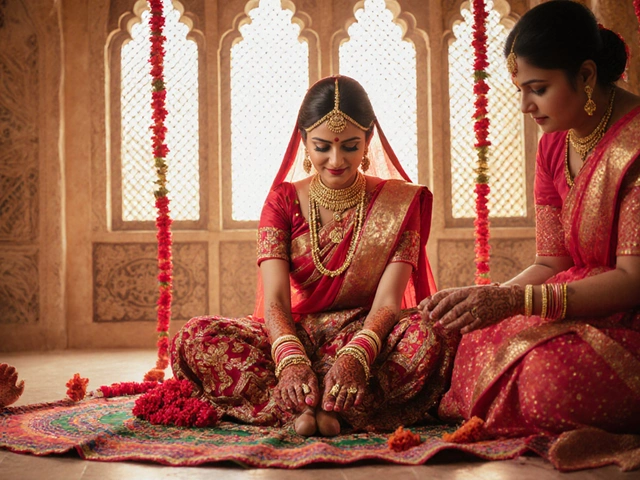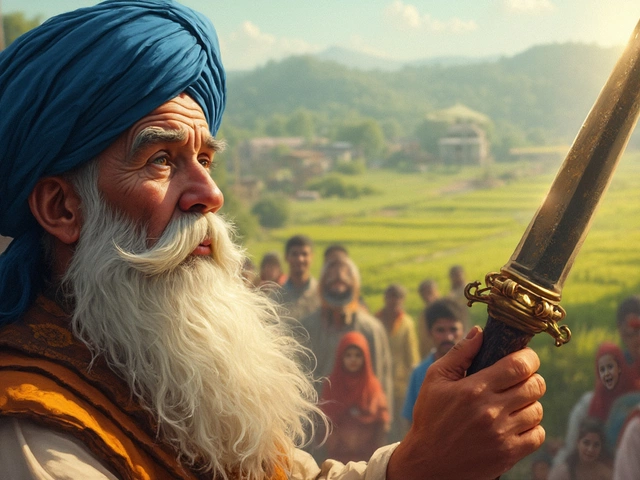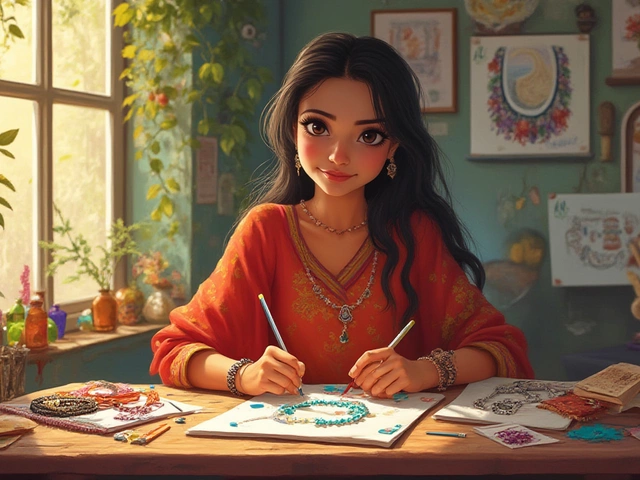In many cultures, jewelry is more than mere ornamentation; it's a reflection of traditions, beliefs, and status. The mangalsutra, an integral part of Indian matrimonial customs, is steeped in rich history and symbolism. Its hallmark black beads are not just decorative; they hold deep-seated meaning and purpose.
As one delves into the world of mangalsutra designs, the mystery and allure of these black beads become evident. Carried through generations, the tradition of incorporating them connects the past with the present. But what do these black beads signify? Are they just another element of design, or do they possess a protective charm?
This article embarks on a journey through time, unraveling the story of mangalsutras and their distinctive black beads. Whether you're a bride-to-be, someone interested in cultural artifacts, or a jewelry enthusiast, understanding the significance behind these black beads offers a fascinating glimpse into their timeless appeal.
- Historical Origins
- Cultural Significance
- Black Beads and Symbolism
- Design Variations
- Tips for Choosing the Perfect Mangalsutra
- Modern Interpretations
Historical Origins
The journey of the mangalsutra and its prominent black beads is as intriguing as it is ancient. The origins of the mangalsutra can be traced back to the early Dravidian civilization where it wasn't just a jewelry piece but symbolized the profound cultural significance of marriage. Initially, in its most basic form, it was nothing more than a simple yellow thread smeared with turmeric. This thread symbolized purity, a new beginning, and was the hallmark of traditional South Indian weddings.
As centuries passed, the simple turmeric thread evolved. Around 6th century AD, it transcended into a more stylized form with the introduction of beads—a practice believed to have been inspired by the growing cultural exchanges through trade routes with Arab merchants, who were known for their beadwork. These beads, particularly the black beads, began to be interwoven into the fabric of the mangalsutra, each bead believed to carry protective powers against malign energies.
The transformation gained momentum during the Tamil Sangam era, a period renowned for its advancement in the arts, culture, and literature. Here, the mangalsutra acquired its illustrious customary designs as intricately carved gold pieces were added, adding layers of meaning to this already symbolic ornament. Historian Aishwarya Menon notes, "The black beads in the traditional design of the mangalsutra served as a talisman, a protective measure against 'drishti' or the evil eye, an unfounded yet deep-rooted belief myriad communities across India adhered to."
Throughout medieval India, various dynasties left their mark on mangalsutra designs, leading to regional variations. For instance, the Nizams of Hyderabad introduced diamond embellishments, while in regions under Maratha rule, the pendant portion gained prominence, signifying prosperity. What remained consistent was the essence these black beads held. They served as reminders of the age-old belief they warded off negative energies, an element that was not only essential but pivotal.
Today, as fashion and culture continue to intermingle and evolve, the historical journey of the mangalsutra still plays a crucial role in how it is perceived. The motifs and materials may have transformed, yet the origins root themselves deeply in the protective and auspicious intentions with which it was conceived. Understanding these origins not only enhances our appreciation but also connects the modern wearers to the historical lineage, symbolizing a continuum of tradition through the lens of history.
Cultural Significance
The mangalsutra is more than a piece of jewelry; it is an iconic symbol with profound cultural importance in Indian marriages. Often given to the bride during the wedding ceremony, the mangalsutra represents a sacred promise between the couple. The ceremony, traditionally known as 'tying the knot,' seals their bond and signifies their union in the eyes of society and tradition. No wedding seems complete without this esteemed ritual, and its importance spans across different regions and communities.
The inclusion of black beads in mangalsutras carries a deep-rooted significance. Historically, black is considered a color that repels negative energy. Thus, these beads serve to protect the marriage from the malevolent gaze and unwarranted misfortune. Each bead acts as a talisman, creating a protective barrier around the couple. Various cultural stories and legends back this belief, providing a mystical aura to these seemingly simple beads.
The Traditions Behind the Beads
In diverse parts of India, the number of black beads, their arrangement, and the accompanying motifs often vary, each signifying a different local tradition or belief. In some communities like the Maharashtrians, nine black beads are arranged at intervals, symbolizing the connection to Navagrahas, the nine celestial bodies. This association emphasizes the balance and harmony they bring to the lives of the couple. The beads are often crafted from glass, onyx, or even jet, each chosen for its durability and protective qualities.
While some people don the mangalsutra daily, adorning it with reverence, others use it ceremonially, reserving it for special religious occasions. Several modern women have embraced their cultural identity by incorporating the mangalsutra into their everyday apparel, all while celebrating its aesthetic appeal. Whether embroidered onto elegant dresses or integrated into western accessories, the black beads continuously emit an aura of protection.
"The mangalsutra reflects the continuity of life and the sanctity of marriage - an age-old tradition passed through generations." - Indian Anthropologist, Dr. Neelima Asthana.
The spiritual dimension that these black beads add to the mangalsutra makes it an enduring symbol that resonates with the cultural and emotional ethos of Indian marriages. It's a gentle reminder of love, belonging, and tradition intertwined beautifully in a humble piece of jewelry.
Therefore, understanding the cultural relevance of these black beads positions them not as mere ornaments but as guardians of a cherished tradition, imbibing the very essence of lifelong commitment. Their importance is immeasurable, and they continue to play a significant role in the journey of matrimony for countless couples, adapting yet enduring, amidst the tides of change.
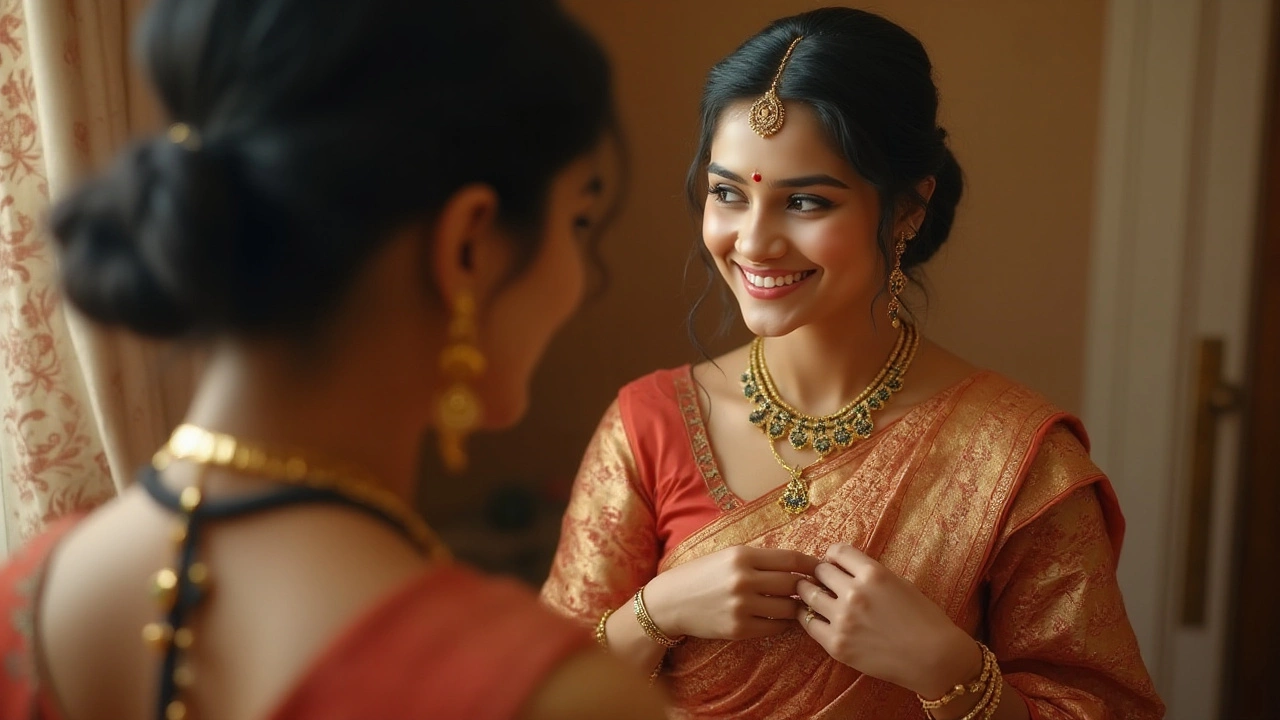
Black Beads and Symbolism
The presence of black beads in a mangalsutra isn't merely an aesthetic choice. Deep-rooted in tradition, these beads carry a wealth of symbolic meaning. Historically, black has been perceived as a color that wards off evil spirits and negative energies. Therefore, incorporating black beads in a piece of marital jewelry is believed to shield the marital bond from negative influences. Each bead, often made of onyx or black glass, is meticulously placed to represent a sort of spiritual armor for the wearer.
Beyond their magical undertones, the black beads in a mangalsutra also symbolize prosperity, good fortune, and a harmonious married life. The traditional belief is that the vibrations emitted by black beads resonate with protective energies, ensuring the well-being and happiness of the couple. In some cultures, people securely weave these beads with gold, which signifies purity, wealth, and the sanctity of marriage. The combination is thought to balance negative and positive energies, creating a harmonious shield around the wearer.
It's interesting to note that these black beads hold personal meanings and differing significance across regions and communities in India. In southern parts of the country, for example, women consider them as a protective veil. In contrast, in the north, it's more of a fashionable reflection of marital status.
The noted jewelry historian, M. Morgan, once wrote, 'The small beads that adorn a woman's mangalsutra are tiny messengers of culture and tradition, whispering tales of protection and love across generations.'This reference to the dual roles these beads play in both spiritual and aesthetic contexts highlights their multifaceted importance.
In today's world, where modernity meets tradition, some question the relevance of such beliefs. However, many brides continue to opt for traditional mangalsutra designs embedded with black beads. Their choice often stems from a deep-seated respect for cultural heritage and an appreciation for age-old crafts. While aesthetics have evolved to include contemporary designs with minimalistic patterns or even diamond settings, the essence of black beads remains a constant. They serve as reminders of the rich tapestry of symbolism that defines Indian culture, echoing values that transcend time and retain their elegance across generations.
For those interested in purchasing a mangalsutra or learning more about its significance, it's important to understand the cultural narrative woven into its design. This knowledge not only enriches the experience of wearing this significant piece of jewelry but also connects the wearer with a heritage that is as enduring as it is beautiful. Exploring regional variations and personal stories can add layers of meaning to what might once have been viewed as merely ornamental.
Design Variations
The mangalsutra is a beautiful representation of tradition and personal style, and its design variations are as diverse as the cultural landscapes it spans. Beyond the customary black beads woven into gold or silver threads, today's mangalsutras offer an array of designs, each celebrating individuality while respecting heritage. From regional styles that adhere strictly to conventional motifs to more modern adaptations, there's a design for every taste.
Traditional mangalsutras often feature the distinctive black beads alongside a delicate chain of gold. This style, deeply rooted in antiquity, is prevalent across many parts of India. In regions like Maharashtra, the beads may be strung in dual or triple rows, symbolizing stability and protection in married life. However, as contemporary tastes evolve, designers innovate, introducing intricate patterns and embellishments, like diamond or gemstone pendants, to complement the classic look.
In South India, the design often combines gold coins with sacred symbols. These coins, called 'thalis', are symbolic and form an integral part of the wedding rituals. In contrast, North Indian styles might showcase elegance in simplicity with fewer black beads and a focus on gold's purity. Variations such as the addition of meenakari work or kundan artistry infuse a splash of color and texture, transforming the accessory into a vibrant statement piece.
Modern designs often blend traditional elements with contemporary flair. For instance, chokers or single-thread mangalsutras provide a minimalist look sought after by today's brides. Some adaptations have seen it transformed into bracelets or layered necklaces, offering not only versatility but also a fresh approach to wearing this important symbol. Fashion-forward yet emotionally grounded, these designs reflect a bride's unique journey and aspirations.
"The black beads in a mangalsutra are not merely a cultural artifact; they are a harmonious blend of tradition and style, timeless and evolving," says Ritu Kumar, an esteemed designer who specializes in ethnic wear.
Ultimately, selecting a mangalsutra is an intimate process that intertwines a woman's identity with a deep-rooted emblem of love and fidelity. As you choose your design, consider how it reflects your personality and life path, honoring the past while embracing the present. Thus, whether you opt for the unembellished grace of a classic style or a contemporary reinterpretation, your choice becomes a cherished narrative of timeless elegance and personal expression.
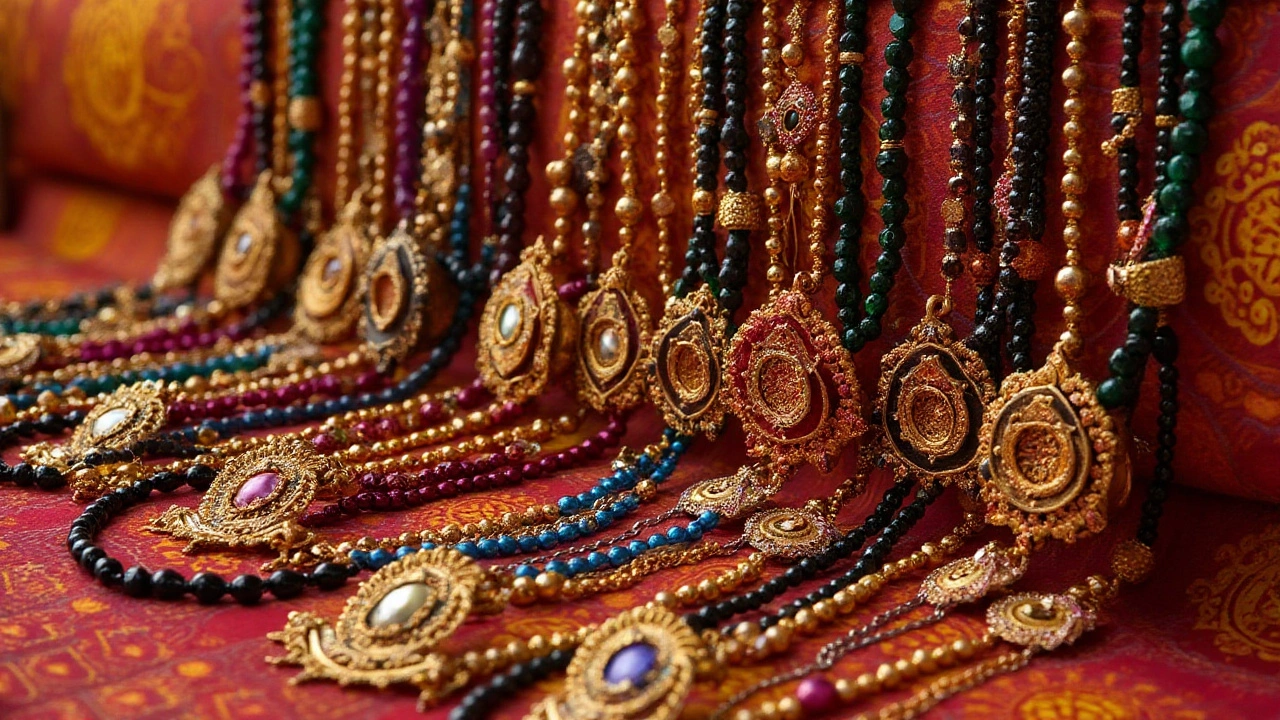
Tips for Choosing the Perfect Mangalsutra
Choosing the ideal mangalsutra can be a daunting experience given its profound significance and symbolic presence in a marriage. It's not just about picking a piece of jewelry; it is about embracing a timeless tradition that resonates with cultural heritage and personal taste. To make the process smoother, it’s essential to consider various elements like design, weight, cost, and personal preferences. Start by determining the style you resonate with—whether you prefer a traditional look or a modern twist, understanding your preference will help streamline your choices.
Materials play a critical role in how the mangalsutra looks and feels. Typically crafted from gold due to its auspiciousness, you might want to explore options that incorporate other materials like diamonds or even artificial stones for a contemporary touch. Don't hesitate to experiment with different combinations until you find the perfect metal and gemstone concoction that complements your persona. Some brides opt for gold-dipped silver to balance budget and aesthetic, which can be an economical yet beautiful choice.
Comfort is another critical aspect to consider. Since a mangalsutra is meant to be worn regularly, it's crucial that it's comfortable enough for daily wear. Ensure the chain length suits your neck well, and pay attention to the weight of the piece. Women often opt for a lighter chain if they plan to wear it every day, avoiding strain. A practical tip here is to try on several pieces to see how each one feels on your skin and how it aligns with your lifestyle.
Personalizing your mangalsutra is increasingly popular as brides look for ways to reflect their uniqueness. Consider working with a jeweler who can customize your piece to include motifs or symbols that hold personal meaning. Whether you're drawn to a minimalist design or something more intricate, personalization can add an exclusive touch to your choice. Some jewelers offer digital previews which can help visualize customization options before settling on the final design.
In the words of famed jewelry designer Meenakshi Shankar,
"A mangalsutra is a symbol of connection. When choosing yours, it should not only reflect your heritage but be a representation of who you are.”This ties in with the emotional and cultural weight such a piece of jewelry carries. Seek a design that resonates at a deeper level, making it not only a marriage emblem but a personal talisman and memento of your journey.
Finally, budgeting for your mangalsutra is crucial. Prices can range widely based on the intricacy of design, choice of materials, and jeweler reputation. Before making a purchase, it's wise to set a budget that takes into account not just the immediate cost but also factors like care and maintenance. Investing in a quality purchase, however, means it can be a timeless piece passed down through generations, thus making it well worth the expenditure.
Modern Interpretations
In today’s vibrant world of jewelry, the iconic mangalsutra has not only retained its traditional essence but has also found itself evolving into contemporary designs that appeal to the modern sensibilities. While the cultural significance of its design elements such as the black beads remains intact, jewellers are exploring innovative ways to make it relevant for a new generation. This push towards modernization sees a harmonious blend of traditional motifs with modern aesthetics, ensuring that the mangalsutra occupies a special place in the hearts of both young brides and seasoned connoisseurs.
Contemporary designers are working to craft mangalsutras that balance tradition and fashion. They've been integrating precious stones, varying black bead arrangements, and gold purity adjustments to personalize pieces. Leading Indian designer Sabyasachi Mukherjee once mentioned, “The mangalsutra embodies a timeless narrative; our goal is to honor that while celebrating the wearer’s unique style.”
Sabyasachi Mukherjee: "The mangalsutra embodies a timeless narrative; our goal is to honor that while celebrating the wearer’s unique style."His statement speaks volumes about the ongoing fusion between age-old beliefs and individual expressions.
Customization plays a pivotal role in modern interpretations. Brides now opt for mangalsutras that reflect their lifestyles while maintaining cultural symbolism. Whether it’s through incorporating their zodiac symbols, initials, or favorite gemstones, the customization potential broadens the appeal. In fact, a report from the Gem & Jewellery Export Promotion Council noted a 20% rise in custom mangalsutra requests in urban areas.
Technology, too, is making an impact. Virtual design tools and augmented reality applications are allowing potential buyers to visualize mangalsutra designs on them before making a purchase. This technological adaptation caters to online shopping trends which have surged in recent years. In particular, an industry survey from 2024 highlighted that over 40% of Indian brides purchased their mangalsutras online, underscoring the need for virtual design revolution.
Ultimately, the modern interpretations of mangalsutras continue to convey the timeless emotion of marriage while embracing innovation. The willingness to adapt without abandoning tradition signifies a promising path forward, ensuring that this cherished piece of Indian jewelry remains a beacon of love stories across generations. Indeed, whether it’s preferring a minimalist style or embracing vibrant modern colors, the essence of the mangalsutra and its sacred black beads endures, capturing the heart and heritage of its wearers through the ages.
